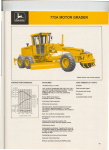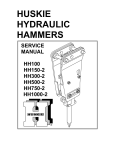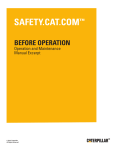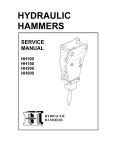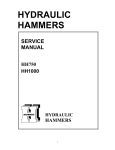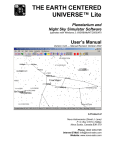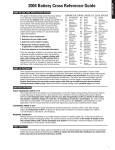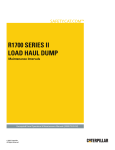Download MAINTENANCE INTERVALS - Safety
Transcript
MAINTENANCE INTERVALS Operation and Maintenance Manual Excerpt © 2010 Caterpillar All Rights Reserved ® ® KEBU6868-06 September 2001 R Operation & Maintenance Manual CS-531C, CP-533C & CS-533C Vibratory Compactors CS-531C: 5ZN1-Up 9RN1-Up CP-533C: 3XN1-Up 3YN1-Up CS-533C: 2WN1-Up 2XN1-Up 71 Maintenance Section Maintenance Intervals (CS/CP-533C) Maintenance Intervals (CS/CP-533C) When Required Engine Air Intake System - Service filters.............73 Fuel System - Service when loss of power ...........94 Fuses and Circuit Breaker - Replace/Reset .........75 Wheel Nuts - Tighten .............................................77 Smooth Drum Scrapers (If Equipped) Adjust/Replace ...................................................78 Smooth Drum Scrapers (Steel) Adjust ................................................................77 Padded Drum Scrapers (If Equipped) Adjust/Replace ....................................................78 Cutting Edge - Replace .........................................79 Platform Tilting - Raise or lower............................80 Oil Filter Inspection - Inspect for debris................81 Fuel System (Later Models) Prime System, Drain Separator ...........................81 Every 10 Service Hours or Daily Engine Crankcase Oil - Check oil level .................82 Hydraulic Oil System - Check oil level, filter indicators....................................................83 Cooling System - Check coolant level, radiator core ......................................................84 Walk-around Inspection - Inspect machine ..........85 Seat Belt - Inspect..................................................86 Indicators and Gauges - Test ...............................87 Back-up Alarm - Test ............................................88 Neutral Start Switch - Check operation.................88 Fuel System (Later Models) Inspect Separator................................................88 Every 50 Service Hours or Weekly * Drum Support Housing - Check oil level ..............98 Vibratory Bearing Reservoir - Check oil level ......99 Drum Drive Planetary - Check oil level ...............101 Fuel System (Later Models) - Change lower secondary element ............................................102 Every 500 Service Hours or 6 Months * Cooling System - Add coolant additive ...............103 Fuel System (Later Models) Change upper secondary element.....................103 Fuel System (Later Models) Replace water separator element ......................104 Hydraulic Oil System/Differential Oil/Drum Gear Reducer Oil - Take SOS Sample .......................104 Every 1000 Service Hours or 1 Year * Hydraulic Oil System -Change charge filters ......105 Engine Crankcase Breather -Clean....................106 Fuel Tank Cap and Fill Screen -Clean strainer...106 Batteries -Check electrolyte level, replace cables .107 Hydraulic Oil System -Change hydraulic oil and clean screen......................................................108 Hydraulic Oil Tank Breather -Replace ...............108 Drum Support Housing -Change oil ...................109 Vibratory Bearing Reservoir -Change oil ...........110 Rollover Protective Structure (ROPS)-Inspect ..111 Propel Pump Sync Rod -Lubricate fittings ..........111 Steering Pivot Clearance -Adjust .......................112 Oscillation Pin -Check end play ..........................112 Differential -Change oil ........................................113 Axle Gear Reducer -Change oil...........................113 Drum Drive Planetary -Change oil ......................114 Tires - Check pressure ...........................................89 Steer Cylinder Ends - Lubricate fittings.................89 Oscillating Pins - Lubricate fittings ........................90 Steering Pins - Lubricate fittings ............................90 Leveling Blade (If Equipped) - Lubricate fittings ..91 Fuel Tank - Drain water and sediment....................91 Every 2000 Service Hours or 2 Years * Initial 250 Service Hours * Every 3000 Service Hours or 3 Years * Hydraulic Oil System - Change filters ................105 Differential - Change oil on machines with new or reconditioned differentials ................................113 Axle Gear Reducer - Change oil .........................113 Drum Drive Planetary - Change oil.....................114 Change POD Oil..................................................117 Every 250 Service Hours or 3 Months * Engine Oil and Filter Change engine oil and filter .................................92 Fuel System (Early Models)-Clean/change filters ....94 Belts -Inspect, adjust..............................................96 Differential -Check oil level ....................................98 Axle Gear Reducer -Check oil level .......................98 Engine Valve Lash and Injector Fuel Timing -Adjust .........................................115 Engine Governor -Clean/replace screen .............115 Cooling System -Change coolant & thermostat/clean system ..............................................................116 * First Perform Previous Service Hour Items. Follow Service Hour or Calender Intervals, Whichever Comes First. 72 Maintenance Section Maintenance Intervals (CS-531C) Maintenance Intervals (CS-531C) When Required Every 250 Service Hours or 3 Months * Engine Air Intake System - Service filters.............71 Fuel System - Service when loss of power ............92 Fuses and Circuit Breaker - Replace/Reset .........73 Wheel Nuts - Tighten .............................................75 Smooth Drum Scrapers (If Equipped) Adjust/Replace ....................................................75 Smooth Drum Scrapers (Steel) Adjust..................................................................76 Platform Tilting - Raise or lower............................78 Oil Filter Inspection - Inspect for debris................79 Fuel System (Later Models) Prime System, Drain Separator ...........................79 Engine Oil and Filter Change engine oil and filter .................................90 Fuel System - Clean/change filters - Early models .92 Belts - Inspect, adjust.............................................94 Differential - Check oil level ...................................95 Axle Gear Reducer - Check oil level ......................96 Drum Support Housings - Check oil level.............96 Vibratory Bearing Reservoir - Check oil level ......97 Fuel System (Later Models) Change lower secondary element .....................100 Every 10 Service Hours or Daily Cooling System - Add coolant additive ..............101 Fuel System (Later Models) Change upper secondary element.....................101 Fuel System (Later Models) Replace water separator element ......................102 Hydraulic Oil System/Differential Oil/Drum Support Housing Oil - Take SOS Sample........................102 Engine Crankcase Oil - Check oil level .................80 Hydraulic Oil System - Check oil level, filter indicators....................................................81 Cooling System - Check coolant level, radiator core ......................................................82 Walk-around Inspection - Inspect machine ..........83 Seat Belt - Inspect..................................................84 Indicators and Gauges - Test ...............................85 Back-up Alarm - Test ............................................85 Neutral Start Switch - Check operation.................86 Fuel System (Later Models) Inspect Separator................................................86 Every 50 Service Hours or Weekly * Tires - Check pressure ...........................................87 Steer Cylinder Ends - Lubricate fittings.................87 Oscillating Pins - Lubricate fittings ........................88 Steering Pins - Lubricate fittings ............................88 Leveling Blade (If Equipped) - Lubricate fittings ..89 Fuel Tank - Drain water and sediment....................89 Initial 250 Service Hours * Hydraulic Oil System - Change filters ................103 Differential - Change oil on machines with new or reconditioned differentials ................................111 Axle Gear Reducer - Change oil .........................111 Every 500 Service Hours or 6 Months * Every 1000 Service Hours or 1Year * Hydraulic Oil System - Change charge filters .....103 Engine Crankcase Breather - Clean...................104 Fuel Tank Cap and Fill Screen - Clean strainer..104 Batteries - Check electrolyte level, replace cables 105 Hydraulic Oil System - Change hydraulic oil and clean screen......................................................106 Hydraulic Oil Tank Breather - Replace ..............106 Drum Support Housings - Change oil ................107 Vibratory Bearing Reservoir - Change oil ..........108 Rollover Protective Structure (ROPS)- Inspect .109 Steering Pivot Clearance - Adjust ......................110 Oscillation Pin - Check end play .........................110 Differential - Change oil .......................................111 Axle Gear Reducer - Change oil..........................111 Every 2000 Service Hours or 2 Years * Engine Valve Lash and Injector Fuel Timing - Adjust .......................................113 Engine Governor - Clean/replace screen ............113 Cooling System - Change coolant & thermostat/clean system ...................................114 * First Perform Previous Service Hour Items. Follow Service Hour or Calender Intervals, Whichever Comes First. 73 Maintenance Section When Required When Required You must read and understand the warnings and instructions contained in the Safety Section of this manual, before performing any operation or maintenance procedures. Engine Air Intake System Service the Filter Elements NOTICE Service the air cleaner only with the engine stopped. Engine damage could result. Clean the Air Intake Empty the precleaner bowl whenever the dirt reaches the full mark. Air Filter Service Indicator - Service the air filter element when red appears in the viewing window or when the arrow is at the 30 INCHES H2O position. Reset the indicator by pushing up on the button. 1. Remove wing nut on cover and remove cover. 2. Empty and wash the precleaner bowl and cover. Service the Primary Element 3. Install the precleaner bowl and cover. 4. Install and tighten the wing nut finger tight only. Do not use a tool. 1. The air filter housing is located on the right side of the machine. 74 Maintenance Section When Required 1 2 1 2. Loosen two cover bolts (1) and remove air cleaner cover (2). 3. Remove the primary filter element from the air cleaner housing. 4. Clean the inside of the air cleaner housing. 5. Clean and inspect the primary element. Refer to Clean Primary Elements in this section. 1. Remove the housing cover and the primary element. Refer to the previous topic, Service Primary Element, for details. 2. Remove the nuts and washers that hold the secondary element to the housing. Remove the secondary element. 3. Cover the air inlet opening. 4. Clean the inside of the air cleaner housing. 6. Install a clean primary element. 7. Clean and install the cover. Tighten the cover bolts finger tight. Do not use a tool to tighten the bolts. 5. Inspect the gasket between the air inlet pipe and the housing. Replace the gasket if it is damaged. 6. Uncover the air inlet opening. 8. Reset the air filter service indicator. 7. Install a new secondary element. If the exhaust smoke is black after starting the engine, or the air filter service indicator shows a restriction after being reset, install a new primary filter element and/or change the secondary filter element. Replace the primary element after being cleaned a maximum of six times. Replace the element once a year even if it has not been cleaned six times. 8. Install the nuts and washers on the studs. Tighten the nuts to a torque of 27 ± 7 N•m (20 ± 5 lb ft). 9. Install the primary element and cover. Tighten the cover bolts finger tight only. Do not use a tool to tighten the cover bolts. 10. Reset the air filter service indicator. Change the Secondary Element NOTICE Always replace the secondary filter element. Never attempt to reuse it by cleaning. Replace the secondary filter element when the primary element is serviced for the third time. Replace the secondary filter element if the exhaust smoke is black after starting the engine or the air filter service indicator shows a restriction after being reset and a new primary element has been installed. 75 Maintenance Section When Required Clean Primary Elements Fuses and Circuit Breaker NOTICE Do not clean the filter elements by bumping or tapping them. Do not use filter elements with damaged pleats, gaskets or seals. Engine damage can result. Replace Fuses Make sure the cleaned filter elements are completely dry before installing into the filter housing. Water remaining in the elements can cause false indications of contamination in Scheduled Oil Sampling test results. Filter elements can be cleaned with pressure air - 205 kPa (30 psi) maximum, pressure water - 280 kPa (40 psi) maximum, or detergent washing. Fuses -The fuses protect the electrical system from damage caused by overloaded circuits. Change a fuse if the element separates. If the element of a new fuse separates, have the circuit checked and repaired. NOTICE Replace fuses with the same type and size only. Otherwise, electrical damage can result. If it is necessary to replace fuses frequently, an electrical problem may exist. Contact your Caterpillar dealer. 1 3 2 1. Direct air or water along the pleats inside and outside of filter element. The element can be washed in warm water and nonsudsing household detergent. Rinse inside and outside the pleats and air dry fully. Fuses are located in front of the right side operators control panel. Starting Aid (1) - 10 amps. Rear Lights (2) - 10 amps. 2. Inspect the filter elements after cleaning. Do not use a filter element with damaged pleats, gaskets or seals. 3. Wrap and store the clean filter elements in a clean, dry place. Engine Start Switch (3) - 10 amps. 76 Maintenance Section When Required 4 6 10 5 10 11 Additional fuses are located on the right side of the operators compartment on machines equipped with a cab. Back-up Alarm (4) - 10 amps. Parking Brake Solenoid (5) - 10 amps. Windshield Wipers (10) - 10 amps. Horn (6) - 10 amps. Heater (11) - 10 amps. Reset Circuit Breaker 7 9 Circuit Breaker Reset -Push the button in to reset the circuit breaker. If working properly, the button will stay depressed. If the button does not stay in, or comes out shortly after being reset, have the electrical circuit checked. 8 Front Lights and Gauge Lights (7) - 10 amps. Vibration System (8) - 10 amps. Gauges (9) - 10 amps. A circuit Breaker is located on the front of the right console. Alternator - 60 amps. 77 Maintenance Section When Required Wheel Nuts Tighten Smooth Drum Scrapers (If Equipped on CS-531/533C) Adjust 1. Inspect the scraper and clean of dirt and debris. Tighten the wheel nuts to a torque of 430 ± 60 N•m (318 ± 44 lb ft). 2. Loosen bolts holding the rear rubber scraper blade. 3. Loosen nuts holding the front rubber scraper blade. 4. Adjust the rubber scraper blades to 7 mm (.25 in) from the surface of the drums. 5. Tighten bolts and nuts. Replace if Damaged 1. Loosen bolts holding the rear rubber scraper blade. 2. Loosen nuts holding the front rubber scraper blade. 3. Slide out rubber blades and replace. 4. Adjust rubber scraper blades. See previous topic for details. 5. Tighten bolts and nuts. 78 Maintenance Section When Required Smooth Drum Scrapers (Steel) Adjust Padded Drum Scrapers (If Equipped on CP-533C) Adjust 1. Inspect the scraper and clean of dirt and debris. 1. Loosen four bolts and nuts. Adjust the steel bar to a clearance of 25 mm (1 in) between the scraper and the drum. Retighten the four bolts and nuts. 2. Loosen four nuts on each end of scraper. 3. Slide scraper toward the drum. Adjust so both top and bottom scraper tips are 25 mm (1 in) from the surface of the drum. 4. Tighten nuts. 79 Maintenance Section When Required Replace 1. Loosen four nuts on each end of scraper. 2. Slide scraper away from drum. Cutting Edge (If equipped on CP-533C) Replace ! WARNING Personal injury or death can result, if the leveling blade is not blocked up. Block the leveling blade before changing cutting edge. 2 1 3. Drive flex-pin (1) out of scraper tip (2). 4. Remove scraper tip. 5. Install new scraper tip on scraper and drive in flexpin. 6. Repeat for remaining scraper tips. 7. Adjust scraper. Refer to the previous topic for details. Replace the cutting edge if damaged or excessively worn. 1. Raise the leveling blade and block it securely. 8. Tighten nuts. Do not block the leveling blade higher then necessary to remove the cutting edge. 2. Remove the bolts and remove the cutting edge. 3. Clean the contact surface. 4. Use the opposite cutting edge if it is not worn. Otherwise, install a new cutting edge. 5. Install bolts and tighten to the specified torque. Refer to Torques for Ground Engaging Tool Bolts in the Torque Specifications section of this manual. 6. Raise the leveling blade and remove the blocks. 7. Lower the leveling blade to the ground. 8. After a few hours of operation, check the bolts for proper torque. 80 Maintenance Section When Required Platform Tilting The platform can be tilted forward to permit easy access to the mechanical and hydraulic components. 6 8 7 5 9 4. Remove bolts (6) and (7) and nuts on each side. 3 1. Remove one bolt (3) and nut on each side of platform. NOTE: There are a total of four bolts holding the platform to the isolation mounts. 5. Install bolt (6) and nut in holes (8) on each side. 6. Lift platform until bottom holes are aligned. Install bolts (7) and the nuts in the holes they were removed from when the holes are aligned with the hole in arm (9). 7. Release lifting tension to hook (5). NOTE: Lower the platform by reversing the procedure for raising the platform. 5 4 2. Remove one bolt (4) and nut on each side of platform. 3. Attach an appropriate lifting device to hook (5). 81 Maintenance Section When Required Oil Filter Inspection Fuel System (Later Models) Inspect Used Filter for Debris Prime the Fuel System 1. Open the right side engine access door. 2 1 Element with debris Use a 4C-5084 Filter Cutter (formerly 6V-7905) to cut the filter element open. Spread pleats apart and inspect the element for metal and other debris. An excessive amount of debris in the filter element can indicate a possible failure. 2. Open valve (1) and push plunger (2) until fuel starts to come out of the valve. 3. Close valve (1). Push plunger (2) an additional ten strokes. 4. Start the engine and check for leaks. Use a magnet to differentiate between ferrous and nonferrous metals found in the filter element. 5. Close the engine access door. Ferrous metals can indicate wear on the steel and cast iron parts. Drain Water Separator 1. Open the right side engine access door. Nonferrous metals can indicate wear on the aluminum parts of the engine, such as main, rod and/or turbocharger bearings. Due to normal wear and friction, it is not uncommon to find small amounts of debris in the filter element. Consult your Caterpillar dealer to arrange for further analysis if an excessive amount of debris is found. Use of an oil filter element not recommended by Caterpillar can result in severe engine damage to engine bearings, crankshaft and other parts. This can result in larger particles in unfiltered oil entering the lubricating system and causing damage. 2. Turn the drain valve counterclockwise to open and allow the water to drain into a suitable container. NOTE: Dispose of drained fluids according to local regulations. 3. Close the drain valve. Close the engine access door. 82 Maintenance Section Every 10 Service Hours or Daily Every 10 Service Hours or Daily You must read and understand the warnings and instructions contained in the Safety Section of this manual, before performing any operation or maintenance procedures. Engine Crankcase Oil 1 2 Check the Oil Level NOTICE Do not overfill the crankcase. Engine damage can result. Check the oil level with the engine stopped. DO NOT check the oil level with the engine running. Park the machine on a level surface. 2. Remove dipstick (1) and wipe it clean. Insert dipstick (1), then remove it again to read actual oil level. Install dipstick (1). NOTE: Refer to Lubricant Viscosities and Refill Capacities in the Maintenance Section of this manual for amount of oil, used at oil change time, to determine the correct position in the FULL range on the dipstick for your application. Badly contaminated or deteriorated oil should be replaced early regardless of the replacement interval. NOTICE Do not overfill to reach above or to the top of the FULL range on the dipstick. 1. The dipstick is located on the right side of the machine. 3. Maintain the oil level between the correct position in the FULL range and ADD marks on the dipstick. Add oil if necessary. 83 Maintenance Section Every 10 Service Hours or Daily NOTE: Operating your engine when the oil level is above the FULL mark in the FULL range zone could cause the crankshaft to dip into the oil. This could lead to excessively high oil temperatures which can reduce the lubricating characteristics of the oil, lead to bearing damage, and could result in loss of engine power. Hydraulic Oil System Check the Oil Level 4. Remove oil fill plug (2). 2 5. Add oil. 6. Check oil level. 1 7. Clean and install oil fill plug (2). 1. Observe the hydraulic oil level when the oil is warm. Maintain oil level to the level mark on the decal near sight gauge (1). 2. Add oil if necessary. 3. Remove oil fill cap (2) and add oil through the fill tube. Clean and install oil fill cap (2). Check Propel Charge Filter Indicator 1. The propel charge filter indicator is on the right side of the hydraulic tank. (Earlier machines had one indicator on the left side of the machine, for both the propel and vibratory systems.) 2. Verify the hydraulic oil filter condition. With the engine running at HIGH IDLE and the hydraulic oil warm, observe the filter indicator. If the indicator is in the red zone, service the hydraulic filter. Refer to Hydraulic Oil System in the Every 1000 Service Hours or 1 Year section of this manual. 84 Maintenance Section Every 10 Service Hours or Daily Check Vibratory Charge Filter Indicator Cooling System 1. The vibratory charge filter indicator is on the left side of the hydraulic tank. Check the Coolant Level 2. Verify the hydraulic oil filter condition. With the engine running at HIGH IDLE and the hydraulic oil warm, observe the filter indicator. If the indicator is in the red zone, service the hydraulic filter. Refer to Hydraulic Oil System in the Every 1000 Service Hours or 1 Year section of this manual. 1. Loosen the radiator fill cap slowly to relieve pressure. Remove the radiator cap. 2. Maintain the coolant level to within 1 cm (1/2 in) of the bottom of the fill pipe. If it is necessary to add coolant daily, check for leaks. 3. Inspect the radiator fill cap and cap seal for damage, deposits or foreign material. Clean the cap with a clean cloth or replace the cap if it is damaged. 4. Install the cap. Inspect the Radiator Core Inspect the radiator core for debris and clean if necessary. Compressed air is preferred, but high pressure water or steam can be used to remove dust, leaves and general debris from a radiator. Clean as required by condition of radiator. 85 Maintenance Section Every 10 Service Hours or Daily Walk-Around Inspection Inspect Machine NOTICE Accumulated grease or oil on a machine is a fire hazard. Remove this debris, with steam cleaning or high pressure water, at least every 1000 hours or each time any significant quantity of oil is spilled on a machine. NOTE: Keep a close watch for leaks. If leaking is observed, find the source and correct the leak. Check the fluid levels more frequently than the recommended periods if leaking is suspected or observed. Inspect the lights for broken bulbs and lenses. Replace if broken. Inspect and remove any trash build-up in the engine compartment. Inspect the cooling system for leaks, faulty hoses and trash build-up. Correct any leaks and remove any trash from the radiator. Inspect all engine attachment belts for wear or damage. Replace if worn, cracked, frayed or broken. Inspect the hydraulic system for leaks. Inspect the tank, cylinder rod seals, hoses, tubes, plugs, joints and fittings. Correct any leaks. Inspect the differential under the machine for leaks. Observe the air filter service indicator. Service the air filter element when red appears in the viewing window or when the arrow is at 30 INCHES H2O position. Inspect tires for damage and proper inflation. Replace any missing valve caps. Be sure the covers and guards are firmly in place. Inspect for damage. Inspect the steps, walkways and handholds for their condition and cleanliness. Inspect the Rollover Protective Structure (ROPS) (if equipped) for damage. If repair is necessary contact your Caterpillar dealer. Tighten any loose ROPS bolts. Inspect the operators compartment for cleanliness. Keep it clean. Adjust the rear view mirrors (if equipped) for best vision. Inspect the engine precleaner bowl for dirt accumulation. Service the precleaner before dirt accumulates close to the full line on the bowl. 86 Maintenance Section Every 10 Service Hours or Daily Seat Belt Inspect for Wear or Damage Inspect the rubber isolation blocks between the vibratory drum and the machine frame for damage, cracking or splitting. Replace the seat belt after three years of usage, regardless of appearance. Seat belt and mounting hardware must be inspected for wear or damage before operating the machine. Replace the belt or mounting hardware if worn or damaged. 87 Maintenance Section Every 10 Service Hours or Daily Indicators and Gauges Back-up Alarm Test for Proper Function Test The back-up alarm is located on the rear of the machine. Look for broken gauge lenses or indicator lights, switches, etc. Start the engine. With the engine running, move the propel control lever to REV (reverse). Look for inoperative gauges. Turn all machine lights on. Check for proper operation. The alarm should start to sound immediately. It will continue to sound until the propel control lever is moved to STOP or FWD. Sound the horn. Stop the engine. NOTE: All four indicator lights should illuminate when the key switch is turned to ON (engine not running). If the indicator lights do not illuminate, repair or replace as necessary. Make any needed repairs before operating. The sound level can be adjusted by moving the adjustment on back of alarm to meet operating requirements. The alarm is set at the highest sound level when shipped from the factory. The setting should remain on high, unless the job site requires a lower level. 88 Maintenance Section Every 10 Service Hours or Daily Neutral Start Switch Fuel System (Later Models) Check Operation Inspect Water Separator ! WARNING Machine may suddenly lurch forward if the neutral start switch is out of adjustment. Be sure area is clear of all personnel and equipment before performing this test. Observe the separator and drain if necessary. See the topic, Drain Water Separator, in the When Required Section. 1. Place propel control lever in FWD (forward). 2. Hold engine start switch in the START position while slowly moving the propel control lever back toward STOP. 3. If machine attempts to start before the lever is in STOP, the neutral start switch requires adjustment. Do not operate machine until repairs are made. Refer to the Service Manual or your Caterpillar dealer for instructions. 89 Maintenance Section Every 50 Service Hours or Weekly Every 50 Service Hours or Weekly You must read and understand the warnings and instructions contained in the Safety Section of this manual, before performing any operation or maintenance procedures. Tires Steer Cylinder Ends Lubricate Fittings Wipe all fittings before lubricating. Check Inflation Pressure There is a grease fitting for each end of each steer cylinder for a total of four fittings. Inflate the tires, if necessary. For normal operating conditions, inflate the tires to: • CS-531/533C - 110 kPa (16 psi) • CP-533C - 83 kPa (12 psi) Refer to the Tire Inflation Information section of this manual. 90 Maintenance Section Every 50 Service Hours or Weekly Oscillating Pins Steering Pins Lubricate Fittings Lubricate Fittings Wipe all fittings before lubricating. Wipe all fittings before lubricating. There is a grease fitting for the front and rear oscillation pins. Both grease fittings are located on the left side of the pivot housing. The two grease fittings for the steering pins are located on the rear frame above and below the pivot housing. NOTE: Some machines have the front fitting at the top of the plate. 91 Maintenance Section Every 50 Service Hours or Weekly Leveling Blade (If Equipped) Lubricate the Fittings Wipe all fittings before lubricating. Lubricate one grease fitting located in the bottom of each pivot lug. A pivot lug is located in the rear of both blade arms. Fuel Tank Lubricate one grease fitting located on the top of the leveling blade cylinder. Drain Water and Sediment Lubricate one grease fitting located on the bottom of the leveling blade cylinder. The drain valve is located on the bottom of the fuel tank. Drain water and sediment into suitable container. NOTE: Always dispose of drained fluids as established by local regulations. 92 Maintenance Section Every 250 Service Hours or 3 Months Every 250 Service Hours or 3 Months You must read and understand the warnings and instructions contained in the Safety Section of this manual, before performing any operation or maintenance procedures. Engine Oil and Filter Change the Oil and Filter Drain the crankcase with the engine stopped and the oil warm to allow for draining of waste particles that are suspended in oil. As oil cools, suspended waste particles settle on the bottom of the crankcase or oil pan and cannot be removed by draining the oil. Failure to follow this recommended procedure can result in waste particles being recirculated through your engine lubrication system with new oil. 2. Open the crankcase oil drain valve. 3. Allow the oil to drain into a suitable container. 4. Close the oil drain valve. 5. Remove the used filter. Refer to Oil Filter Inspection in the When Required section of this manual for the procedure used to inspect the oil filter. NOTE: Always dispose of used oil and filters as established by local regulations. 6. Clean the gasket sealing surface of the filter housing base. Make sure all of the old filter gasket is removed. 7. Apply a light coating of engine oil to the gasket of the new filter. 1. The oil filter and drain valve are located on the left side of the machine. 8. Install the new filter by hand. When the gasket contacts the filter base, tighten the filter 3/4 turn more. Do not overtighten. 93 Maintenance Section Every 250 Service Hours or 3 Months 11. Before starting the engine, make sure the oil level is in the FULL range on dipstick (2). 12. Start and run the engine at low idle for two minutes. Inspect for oil leaks. Stop the engine. 13. Wait 10 minutes to allow the oil to drain back into the crankcase. Check the oil level. Maintain the oil level to the correct position in the FULL range as determined in Step 10. 9. The oil fill plug and dipstick is located on the right side of the machine. 2 1 10. Remove oil fill plug (1). Fill the crankcase with new oil. NOTE: Refer to Lubricant Viscosities and Refill Capacities in the Maintenance Section of this manual for the proper oil and the proper amount of oil, used at oil change time, to determine the correct position in the FULL range on dipstick (2). NOTICE Do not overfill to reach above or to the top of the FULL range on the dipstick. Operating your engine when the oil level is above the FULL mark in the FULL range zone could cause the crankshaft to dip into the oil. This could lead to excessively high oil temperatures which can reduce the lubricating characteristics of the oil, lead to bearing damage, and could result in loss of engine power. 94 Maintenance Section Every 250 Service Hours or 3 Months Fuel System (Earlier Models) Clean and Change Filters NOTICE Do not fill fuel filters with fuel before installing them. Contaminated fuel will cause accelerated wear to fuel system parts. 5. Insert the clean element. Install the element and case into housing. Tighten the retaining bolt. NOTE: Do not start the engine until all fuel system service is completed. Refer to Priming the System in this section for engine starting procedure following fuel system service. Change Secondary Fuel Filter Wash the Primary Filter Element 1. Remove and discard the filter. 1. The primary fuel filter is located on the right side of the machine. NOTE: Always dispose of drained fluids and filters as established by local regulations. 2. Clean the gasket sealing surface of the filter base. Make sure all of the old gasket is removed. 3. Apply a light coating of clean diesel fuel to the new fuel filter gasket. NOTICE Do not fill the fuel filters with fuel before installing them. This fuel would not be filtered and could be contaminated. Contaminated fuel will cause accelerated wear to the fuel system parts. 2. Loosen the filter housing retaining nut. Remove the housing and element. 3. Remove the element from the case. Wash the element and housing in clean, nonflammable solvent. 4. Dry the element using pressure air. Clean the filter case base. Inspect the seal. Replace seal if it is damaged. 95 Maintenance Section Every 250 Service Hours or 3 Months 4. Install the filter and tighten by hand until the filter gasket contacts the base. Tighten the filter 3/4 turn more. NOTE: Do not start the engine until all fuel system service is completed. Refer to Priming the System in this section for engine starting procedure following fuel system service. Clean the Fuel Inlet Screen 1. Unlock and operate the priming pump plunger until a resistance is felt. 2. Push the plunger in and tighten by hand. 3. Start the engine. If the engine will not start, or once started continues to misfire or smoke, further priming is necessary. Repeat Steps 1-3. 1. Remove the fuel inlet screen located at the inlet to the fuel transfer pump. 2. Clean the screen with a nonflammable solvent. 3. Install the screen in the fuel line and tighten the fitting. NOTE: Do not start the engine until all fuel system service is completed. Refer to Priming the System in this section for engine starting procedure following fuel system service. Priming the System NOTE: There should be enough fuel in the system to allow the engine to start. If the engine runs, and then stops, crank the engine for a period of 30 seconds, then allow the starter to cool for two minutes. Repeat this cranking and cooling cycle several times or until the engine starts and runs. NOTE: If difficulty is encountered in starting the engine or the engine continues to start and die, it may be necessary to prime the fuel system. If the engine starts, but runs rough, continue running the engine at low idle until the engine runs smoothly. 96 Maintenance Section Every 250 Service Hours or 3 Months Belts Water Pump Belt Adjustment Inspect For maximum engine performance and utilization of your engine, inspect the belts for wear and cracking. Check and adjust the belt tension to minimize belt slippage. Belt slippage can decrease belt life and cause poor performance of alternator and any belt driven equipment. 1. Inspect the condition of the belts. 4 2 1 3 2. Inspect the tension of the alternator belts. 1. Loosen mounting bolt (1) and bracket bolt (2). 2. Move idler pulley (3) as required to obtain the correct tension. If necessary, use a pry bar in square hole (4) in the mounting bracket. 3. Tighten bolts (1) and (2). 4. If a new belt is installed, check the belt adjustment after 30 minutes of engine operation at rated speed. To check the alternator belt tension, apply 110 N (25 lbs) of force midway between the pulleys. Correctly adjusted belts will deflect 14 to 20 mm (9/16 to 13/16 in). If a new belt is installed, check belt adjustment after 30 minutes of operation. For multiple belt drive applications, always replace belts in matched sets. If only one belt of a matched set is replaced, it will carry more of a load than the belts not replaced since the older belts are stretched. The additional load on the new belt could cause it to break. 97 Maintenance Section Every 250 Service Hours or 3 Months Alternator/Fan Belts Adjustment 2 Differential Check Oil Level 1 1 2 1. Loosen mounting bolt (1) and bracket bolt (2) on the alternator bracket. 2. Move alternator as required to obtain the correct tension. There is a check plug (2) and fill plug (1) located on the right side of the flange on the differential case. 3. Tighten bolts (1) and (2). 1. Remove check plug (2). Maintain the oil level to the bottom of the check plug opening. NOTE: Alternator shaft nut must be tightened to 50 ± 5 N•m (37 ± 4 lb ft). 2. If the oil level is low, remove fill plug (1). 4. Check and adjust the position of the fan shroud to ensure that the fan will not rub on the shroud. Maintain a 9.4 mm (.38 in) clearance between the fan and shroud. 3. Add oil until it is to the proper level. 4. Clean and install check plug (2) and fill plug (1). 98 Maintenance Section Every 250 Service Hours or 3 Months Axle Gear Reducer Check Oil Level Drum Support Bearing Housing Check Oil Level There is a fill/check plug located on the left side of the differential gearbox. The drum support bearing housing is located on the right side of the drum. 1. Remove the fill/check plug to check the fluid level of the differential gearbox. Maintain the oil level to the bottom of the fill/check plug opening. 2. Add oil to the proper level. 1 3. Clean and install fill/check plug. NOTE: The axle gear reducer and differential for the axle have a common oil reservoir. For this reason, the oil level in one may be higher or lower than the other depending on the check plug positioning of the two. The axle differential check plug should be used to control the oil level between the differential and axle gear reducer. Bottom view of drum support bearing housing on machines with serial numbers (2WN1-233), (2XN 1-525), (3XN1-102), (3YN195), (5ZN1-171), (9RN1-565). 1 Bottom view of drum support bearing housing on machines with serial numbers (2WN234-Up), (2XN 526-Up), (3XN102-Up), (3YN96-Up), (5ZN172-Up), (9RN566-Up). 99 Maintenance Section Every 250 Service Hours or 3 Months 1. Remove check plug (1) to check the fluid level of the housing. Maintain the oil level to the bottom of the Vibratory Bearing Reservoir Check Oil Level NOTE: The weight shaft bearing reservoir is located on the right side of the drum for machines with serial numbers (2WN1-233), (2XN 1-525), (3XN1-102), (3YN1-95), (5ZN1-171), (9RN1-565). Machines with serial numbers (2WN234-Up), (2XN 526-Up), (3XN102-Up), (3YN96-Up), (5ZN172-Up), (9RN566Up), have separate weight shaft bearing reservoirs, one on each side of the drum, it is essential that the oil level on both sides is checked. 2 check plug opening. 1 2 1. Move the machine until welded item (1) is at the 6 o’clock position . Top view of drum support bearing housing on machines with serial numbers (2WN1-233), (2XN 1-525), (3XN1-102), (3YN195), (5ZN1-171), (9RN1-565). 2 Top view of drum support bearing housing on machines with serial numbers (2WN234-Up), (2XN 526-Up), (3XN102-Up), (3YN96-Up), (5ZN172-Up), (9RN566-Up). 2. If the oil level is low, remove fill plug (2). 3. Add oil to the proper level. 4. Clean and install check plug (1) and fill plug (2). Bottom view of vibratory bearing reservoir on machines with serial numbers (2WN1-233), (2XN 1-525), (3XN1-102), (3YN195), (5ZN1-171), (9RN1-565). 100 Maintenance Section Every 250 Service Hours or 3 Months 3 2 Bottom view of vibratory bearing reservoir on machines with serial numbers (2WN234-Up), (2XN 526-Up), (3XN102-Up), (3YN96-Up), (5ZN172-Up), (9RN566-Up). Top view of vibratory bearing reservoir on machines with serial numbers (2WN234-Up), (2XN 526-Up), (3XN102-Up), (3YN96Up), (5ZN172-Up), (9RN566-Up). 2. Remove check plug (2). Maintain oil to the bottom of the check plug opening. 3. If the oil level is low, remove fill plug (3). 4. Add oil to the proper level. 5. Clean and install check plug (2) and fill plug (3). 3 Obtain Sample for SOS Take a sample for SOS analysis. Top view of vibratory bearing reservoir on machines with serial numbers (2WN1-233), (2XN 1-525), (3XN1-102), (3YN1-95), (5ZN1-171), (9RN1-565). 101 Maintenance Section Every 250 Service Hours or 3 Months Drum Drive Planetary Check Oil Level 1. On machines with serial numbers (2WN1-233), (2XN 1-525), (3XN1-102), (3YN1-95), (5ZN1-171), (9RN1-565), it will be necessary to rotate the drum until plug (1) is at the 3 or 9 o'clock position. Machines with serial numbers (2WN234-Up), (2XN 526-Up), (3XN102-Up), (3YN96-Up), (5ZN172-Up), (9RN566-Up), have these plugs located in a fixed position. 2. Remove check plug (1) to check the fluid level of the planetary. Maintain the oil level to the bottom of the check plug opening. The drum drive planetary is located on the left side of the drum. 1 2 Top view of drum drive planetary on machines with serial numbers (2WN1-233), (2XN 1-525), (3XN1-102), (3YN1-95), (5ZN1-171), (9RN1-565). 2 View of drum drive planetary on machines with serial numbers (2WN1-233), (2XN 1-525), (3XN1-102), (3YN1-95), (5ZN1-171), (9RN1-565). Top view of drum drive planetary on machines with serial numbers (2WN234-Up), (2XN 526-Up), (3XN102-Up), (3YN96Up), (5ZN172-Up), (9RN566-Up). 3. If the oil level is low, remove fill plug (2). 1 4. Add oil to the proper level. 5. Clean and install the drain and check plugs. View of drum drive planetary on machines with serial numbers (2WN234-Up), (2XN 526-Up), (3XN102-Up), (3YN96-Up), (5ZN172-Up), (9RN566-Up). 102 Maintenance Section Every 250 Service Hours or 3 Months Fuel System (Later Models) Change Lower Secondary Filter Element 1. Open the engine access door on the right side of the machine. 1 2 4 3 NOTE: The upper (inverted) filter element must be drained before removal or replacement of either filter element. 2. Place a suitable container under drain valves (2) and (3). Drain upper secondary filter element (1) by opening drain valve (3) first. Immediately open drain valve (2) after opening drain valve (3). This sequence is important to prevent an air lock in the fuel system. 3. After the fuel drains, slightly loosen upper secondary element (approximately 1/4 turn). As the filter is loosened, additional fuel may drain. Loosen the filter another 1/4 turn and repeat as necessary until fuel no longer drains from the valves. 4. Close the drain valves. 5. If the upper secondary filter element is not being changed, tighten the upper secondary filter element by hand until the seal contacts the base. Tighten an additional 3/4 turn. 6. Remove the (lower) secondary filter element. Use care to avoid spilling fuel from the secondary filter element as it is being removed. 7. Install a new lower secondary element. Do not prefill the element with fuel. This could introduce contaminants into the fuel system. Tighten the lower secondary filter element by hand until the seal contacts the base. Tighten an additional 3/4 turn. 8. Prime the fuel system. See the topic, Fuel System (Later), Priming the Fuel System, under When Required.Fuel System (Later Models) 103 Maintenance Section Every 500 Service Hours or 6 Months Every 500 Service Hours or 6 Months You must read and understand the warnings and instructions contained in the Safety Section of this manual, before performing any operation or maintenance procedures. Cooling System Fuel System (Later Models) Change Upper Secondary Filter Element 1. Open the engine access door on the right side of the machine. Add Supplemental Coolant Additive 1 Refer to the Cooling System Specifications section of this manual for all cooling system requirements. 2 Use the 8T-5296 Test Kit to check for concentration. 4 3 NOTICE Excessive additive (greater than the recommended 6% initial fill) together with concentrations of antifreeze greater than 60% cause deposits to form and can result in radiator tube blockage and overheating. Liquid Supplemental Coolant Additive NOTE: Upper secondary filter element (1) must be drained before removal or replacement of either filter element. 2. Place a suitable container under drain valves (2) and (3). Drain upper secondary filter element (1) by opening drain valve (3) first. Immediately open drain valve (2) after opening drain valve (3). This sequence is important to prevent an air lock in the fuel system. 3. After the fuel drains, slightly loosen upper secondary element (1) approximately 1/4 turn. As the filter is loosened, additional fuel may drain. Loosen the filter another 1/4 turn and repeat as necessary until fuel no longer drains from the valves. 4. Close the drain valves. 1. Loosen the radiator fill cap slowly to relieve pressure. Remove the radiator fill cap. 2. It may be necessary to drain enough coolant from the radiator to allow for the addition of the liquid cooling system additive. 3. Add .24 liters (1/2 pint) of additive for every 38 liters (10 U.S. gallons) of cooling system capacity. NOTE: Maintain the coolant level to within 1 cm (1/2 in) of the bottom of the fill pipe. 4. Inspect the radiator fill cap. Replace the cap if it is damaged. 5. Clean and install the radiator fill cap. 5. Remove upper secondary filter element (1). Use care to avoid spilling fuel from the secondary filter element as it is being removed. 6. Install a new upper secondary fuel filter element. Tighten the upper secondary filter element by hand until the seal contacts the base. Tighten an additional 3/4 turn. 7. Prime the fuel system. See the topic, Fuel System (Later), Priming the Fuel System, under When Required. 104 Maintenance Section Every 500 Service Hours or 6 Months Fuel System (Later Models) Replace Water Separator Element 8. Install bowl (5). Tighten collar (4). 9. Close the engine access door. Hydraulic Oil System Obtain SOS Sample Take an oil sample for SOS analysis. See Scheduled Oil Sampling Section for Instructions. Differential Oil Obtain Oil Sample 1 1. Open the engine access door on the right side of the machine. 2. Turn valve (1) counterclockwise and drain the fuel into a suitable container. 3. Close valve (1). Take an oil sample for SOS analysis. See scheduled Oil Sampling Section for instructions. Drum Gear Reducer Oil (CS/CP-533C Only) Obtain Oil Sample Take an oil sample for SOS analysis. See scheduled Oil Sampling Section for instructions. Drum Support Housings (CS-531C Only) Obtain Oil Sample Take an oil sample for SOS analysis. See scheduled Oil Sampling Section for instructions. 2 3 4 5 4. Hold bowl (5) while loosening collar (4). Remove bowl (5) and collar (4). 5. Loosen collar (2). Remove element (3) and discard. 6. Clean and inspect all parts. 7. Install a new element. Tighten collar (2). 105 Maintenance Section Every 1000 Service Hours or 1 Year Every 1000 Service Hours or 1 Year You must read and understand the warnings and instructions contained in the Safety Section of this manual, before performing any operation or maintenance procedures. Hydraulic Oil System Change Propel/Vibratory Charge Filters NOTICE Take extreme care to insure the cleanliness of hydraulic oil. Keep hydraulic oil clean to extend component life and assure maximum performance. 3. Observe the hydraulic oil level with the oil warm. Maintain the oil level to the level mark on the decal near the sight gauge. Add oil if necessary. All CS-531C & CS/CP-533C Machines CS/CP-533C Machines Only 1. Remove the filter elements and clean the filter bases. 2. Install new filter elements. 106 Maintenance Section Every 1000 Service Hours or 1 Year Engine Crankcase Breather Fuel Tank Cap and Fill Screen Clean Clean 1. The crankcase breather is located on the right side of the machine. 1. Remove the fuel tank cap and strainer. 2. Inspect the cap. Replace the cap if it is damaged. 4 1 3 3. Wash the strainer in clean, nonflammable solvent and dry. 4. Install the strainer. 2 5. Apply a light coating of fuel oil to the fuel tank cap gasket. 6. Install the fuel tank cap. 2. Loosen hose clamp (1) and slide hose (2) from breather (3). 3. Loosen bolt (4). 4. Remove breather (3) and O-ring seal. 5. Wash breather (3) in clean nonflammable solvent. Dry the breather with pressure air. 6. Inspect the O-ring seal and replace it if it is damaged. 7. Install O-ring seal and clean breather (3). 8. Tighten breather bolt (4) to 7 ± 2 N·m (5 ± 1 lb ft). 9. Slide hose (2) onto breather (3) and tighten hose clamp (1). 10. Close the access cover. 107 Maintenance Section Every 1000 Service Hours or 1 Year Batteries ! WARNING Improper procedures can cause an explosion resulting in personal injury or machine damage. Always disconnect the negative (-) battery cable BEFORE servicing the battery or positive (+) battery cable. Install battery and/or positive (+) battery cable completely BEFORE connecting the negative (-) battery cable. Do not allow battery cable ends to contact each other or the machine. 1. Open the battery access cover located on the rear of the machine. NOTICE Refer to Special Instruction, Battery Test Procedure, SEHS7633, available from your Caterpillar dealer, for complete testing and charging information. Check Electrolyte Level BATTERY ELECTROLYTE CHART Battery Conventional CH-Electrolyte Chart Low Maintenance Maintenance Free Interval 100 Hours 250 Hours None Required At the proper charging rate, in a moderate climate, a battery should not require more than 30 cc (1 ounce) of water per cell per week. Check the cells weekly in extreme temperatures, cell water usage could be higher. Check the following at least every 1000 hours, and more often as conditions require: 2. Clean the battery surface with a clean cloth. Keep the terminals clean and coated with petroleum jelly. Install the post covers after coating. 3. Inspect the electrolyte level in each battery cell, except on maintenance free batteries. Maintain the level to the bottom of the fill openings with distilled water. If distilled water is not available, use clean drinking water. 4. Close the battery access cover. Replacement of Battery or Battery Cable • Clean the top of the batteries with a clean cloth. • Keep the terminals clean and coated with petroleum jelly. • Tighten the battery retainers on all batteries. 1. Turn the engine start switch to OFF. Turn all switches to the OFF position. 2. Disconnect the negative (-) battery cable at the frame of the machine. Do not allow cable end to contact any part of the machine. 3. Make necessary repairs or replacements. 4. Connect the negative battery cable. 108 Maintenance Section Every 1000 Service Hours or 1 Year Hydraulic Oil System Change Oil NOTICE Take extreme care to insure the cleanliness of hydraulic oil. Keep hydraulic oil clean to extend component life and assure maximum performance. NOTE: The hydraulic oil tank contains approximately 118 liters (31 U.S. gallons) of hydraulic oil. Drain oil into a suitable container. Always dispose of used oil as established by local regulations. 6. Close the hydraulic oil tank drain valve and remove the hose. 7. Refill the hydraulic oil tank with clean, filtered hydraulic oil. Refer to Lubricant Viscosities and Refill Capacities in the Maintenance Section of this manual. 8. Remove the hydraulic oil tank cap and add oil through the fill tube. Clean and install the cap. 1 9. Maintain the oil level to level mark (2) on the decal near the sight gauge. 10. Install hydraulic oil tank cap (1). 2 Hydraulic Oil Tank Breather Replace the Breather 1. Remove hydraulic oil tank cap (1) and strainer. 1. Tilt the platform forward. Refer to Platform Tilting in the When Required section. 2. Wash hydraulic oil tank cap (1) and strainer in clean, nonflammable solvent. NOTE: The breather is located on top of the hydraulic tank. 3. Install the strainer. 2. Remove the hydraulic oil tank breather. 3. Install a new hydraulic oil tank breather. 4. Lower the platform. Refer to Platform Tilting in the When Required section. 4. Connect a hose to the hydraulic oil tank drain valve located at the bottom right side of the hydraulic oil tank. 5. Open the hydraulic oil tank drain valve. Allow the oil to completely drain. 109 Maintenance Section Every 1000 Service Hours or 1 Year 1. Remove drain plug (2) and allow the oil to drain into a suitable container. Drum Support Bearing Housing NOTE: Always dispose of used oil as established by local regulations. Change Oil 2. Clean and install drain plug (2). 3. Remove oil level check plug (1). 3 The drum support bearing housing is located on the right side of the drum. Top view of drum support bearing housing on machines with serial numbers (2WN1-233), (2XN 1-525), (3XN1-102), (3YN195), (5ZN1-171), (9RN1-565). 1 3 2 1 Bottom view of drum support bearing housing on machines with serial numbers (2WN1-233), (2XN 1-525), (3XN1-102), (3YN195), (5ZN1-171), (9RN1-565). Top view of drum support bearing housing on machines with serial numbers (2WN234-Up), (2XN 526-Up), (3XN102-Up), (3YN96-Up), (5ZN172-Up), (9RN566-Up. 1 4. Remove fill plug (3). 2 5. Add oil through the fill plug opening. Maintain the oil level to the bottom of oil level check plug opening. Refer to Lubricant Viscosities and Refill Capacities in the Maintenance Section of this manual. 6. Clean and install oil level check plug (1) and fill plug (3). Bottom view of drum support bearing housing on machines with serial numbers (2WN234-Up), (2XN 526-Up), (3XN102-Up), (3YN96-Up), (5ZN172-Up), (9RN566-Up). 7. CS-531C only- Repeat the above steps on the left side drum support bearing housing. 110 Maintenance Section Every 1000 Service Hours or 1 Year Vibratory Bearing Reservoir Change the Oil NOTE: The weight shaft bearing reservoir is located on the right side of the drum for machines with serial numbers (2WN1-233), (2XN 1-525), (3XN1-102), (3YN1-95), (5ZN1-171), (9RN1-565). 2. Remove drain/fill plug (2) and allow the oil to drain into a suitable container. Clean the drain plug. NOTE: Always dispose of used oil as established by local regulations. NOTE: Machines with serial numbers (2WN234-Up), (2XN 526-Up), (3XN102-Up), (3YN96-Up), (5ZN172Up), (9RN566-Up), have separate weight shaft bearing reservoirs, one on each side of the drum. Weight shaft bearing reservoir oil change on these machines will be covered under the every 3000 service hours or 3 years section. 1 3. Move the machine until welded item (1) on the drum is straight down and the left side of the drum is no longer blocked up. 1 3 The weight shaft bearing reservoir is located on the right side of the drum. 1. Move the machine until welded item (1) on the drum is straight up. NOTE: Blocking the drum up on the left side (propel motor side) approximately 12 inches will help to assure complete oil removal. Bottom view. 4. Remove check plug (3). 2 5. Add oil through the drain/fill plug, now positioned at the top of the drum. Maintain the oil to the bottom of the check plug opening. Refer to Lubricant Viscosities and Refill Capacities in the Maintenance Section of this manual. 6. Clean and install drain/fill plug (2) and check plug (3). Bottom view. 111 Maintenance Section Every 1000 Service Hours or 1 Year Rollover Protective Structure (ROPS) (If Equipped) Propel Pump Sync Rod (CS/CP-533C) Inspect Lubricate the Fittings Wipe all fittings before lubricating. Inspect for any loose or damaged bolts. Replace damaged bolts or missing bolts with original equipment parts only. Tighten bolts to a torque of 400 ± 10 N•m (296 ± 7 lb ft). 1. The sync rod is located at the right side of the machine. NOTE: Apply oil to all ROPS bolt threads before installing. Failure to apply oil can result in improper bolt torque. Replace ROPS mounting supports if the ROPS rattles or makes a noise when the machine is operated on a rough surface. Do not straighten or repair by welding reinforcement plates to the ROPS. Contact your Caterpillar dealer for repair of cracks in welds, castings or any metal section on the ROPS. 2. Lubricate two fittings. 112 Maintenance Section Every 1000 Service Hours or 1 Year Steering Pivot Clearance Oscillation Pin Adjust Check End Play Refer to the Service Manual (CS-531C - KENR 2716, CP/CS-533C - KENR 2669) for the complete procedure to perform this maintenance. Refer to the Service Manual (CS-531C - KENR 2716, CP/CS-533C - KENR 2669) for the complete procedure to perform this maintenance. 113 Maintenance Section Every 1000 Service Hours or 1 Year Differential Axle Gear Reducer Change Oil Change Oil 2 1 1 1. Remove drain plug (1) located at the bottom of differential case. Allow the oil to drain. 1. Remove reducer drain plug (1). 2. Remove reducer fill/check plug (2) located on the side of the flange. 3. Maintain oil level to the bottom of plug (2). Refer to Lubricant Viscosities and Refill Capacities in the Maintenance Section of this manual. 2 3 NOTE: The axle gear reducer has a common reservoir with the differential. Oil may be added through the differential fill plug. 4. Clean and install plugs (1) and (2). 2. Remove differential fill plug (2) and check plug (3). NOTE: Drain oil into a suitable container. Always dispose of used oil as established by local regulations. 3. Install drain plug (1). Add oil to the differential. Maintain oil level to the bottom of plug (3). Refer to Lubricant Viscosities and Refill Capacities in the Maintenance Section of this manual. 4. Clean and install fill and check plugs. 114 Maintenance Section Every 1000 Service Hours or 1 Year Drum Drive Planetary (CS/CP533C Only) Change Oil 2 1 2 1 View of drum drive planetary on machines with serial numbers (2WN1-233), (2XN 1-525), (3XN1-102), (3YN1-95), (5ZN1-171), (9RN1-565). 1 View of drum drive planetary on machines with serial numbers (2WN1-233), (2XN 1-525), (3XN1-102), (3YN1-95), (5ZN1-171), (9RN1-565). 2 1 Top view of drum drive planetary on machines with serial numbers (2WN234-Up), (2XN 526-Up), (3XN102-Up), (3YN96Up), (5ZN172-Up), (9RN566-Up. Bottom view of drum drive plantary on machines with serial numbers (2WN234-Up), (2XN 526-Up), (3XN102-Up), (3YN96Up), (5ZN172-Up), (9RN566-Up). 1. On machines with serial numbers (2WN1-233), (2XN 1-525), (3XN1-102), (3YN1-95), (5ZN1-171), (9RN1-565), it will be necessary to rotate the drum until plug (1) is at the bottom or 6 o'clock position. Machines with serial numbers (2WN234-Up), (2XN 526-Up), (3XN102-Up), (3YN96-Up), (5ZN172-Up), (9RN566-Up), have these plugs located in a fixed position. 2. Remove planetary drain plug (1). 3. After oil is completely drained, install the drain plug. 4. On machines with serial numbers (2WN1-233), (2XN 1-525), (3XN1-102), (3YN1-95), (5ZN1-171), (9RN1-565), it will be necessary to rotate drum until plug (1) is at 12 o'clock position and plug (2) is at 3 o'clock or 6 o'clock position. Machines with serial numbers (2WN234-Up), (2XN 526-Up), (3XN102-Up), (3YN96-Up), (5ZN172-Up), (9RN566-Up), have these plugs located in a fixed position. 5. Refer to Lubricant Viscosities and Refill Capacities in the Maintenance Section of this manual. 6. Fill to bottom of plug (2) opening. NOTE: On machines with serial numbers (2WN234Up), (2XN 526-Up), (3XN102-Up), (3YN96-Up), (5ZN172-Up), (9RN566-Up), it is necessary to allow for longer settling time for the oil. 7 Clean and install plugs (1) and (2). 115 Maintenance Section Every 2000 Service Hours or 2 Years Every 2000 Service Hours or 2 Years Engine Valve Lash and Injector Fuel Timing Engine Governor Clean/Replace the Screen Check/Adjust Refer to the Service Manual (SENR 3583-04) for the complete procedure to perform valve lash check and/or adjustment. NOTE: Be sure to have a qualified mechanic check and/or adjust injector fuel timing. Special tools and training are required. Refer to the Service Manual (SENR 3583-04) for the complete procedure to perform this maintenance. NOTE: The correct fuel timing specification is given on the Engine Information Plate. Fuel timing specifications may be different for different engine applications and/or power ratings. 1. The governor is located at the right side of the machine. 2. Remove oil supply tube (1) from cylinder head and remove fitting (2) and seals (3) from the governor housing. 3. Remove screen (4) using a 6 mm hexagon wrench. 4. Wash screen (4) in solvent to remove any debris and inspect screen (4) and the seals for damage. Replace any parts if necessary. 5. Install screen (4) deep enough to allow clearance for fitting (2). 6. Install seals (3), fitting (2) and oil supply tube (1). 116 Maintenance Section Every 3000 Service Hours or 2 Years Cooling System 4. Fill the system with clean water and a 6 to 10% concentration of cooling system cleaner. Change Coolant & Thermostat/Clean System 5. Start and run the engine for 1 1/2 hours. NOTICE Do not change the coolant until you read and understand the material in the Cooling System Specifications section. Drain the coolant earlier if the coolant is dirty or foaming is observed. 6. Stop the engine. Open the drain valve at the bottom of the radiator and allow coolant to drain. 7. Flush the system with water, with the engine stopped, until the draining water is clear. 8. Close the drain valve. Install a new thermostat. See the service manual for complete instructions. 9. Add the coolant solution. Refer to Cooling System Specifications and Lubricant Viscosities and Refill Capacities in the Maintenance Section of this manual. NOTE: Do not add supplemental coolant additive at this time, unless you are not using Caterpillar Antifreeze which contains additive. 10. Start the engine and operate it, with the radiator cap off, until the thermostat opens and the level stabilizes. 11. Maintain the coolant level to within 1 cm (one-half in) of the bottom of the fill pipe. 1. Remove the radiator cap slowly to relieve pressure. 12. Replace the radiator cap if the gasket is damaged. Install the cap. 13. Stop the engine. 2. Open the drain valve at the bottom of the radiator and allow coolant to drain. NOTE: Drain coolant into a suitable container. Always dispose of drained fluids as established by local regulations. 3. Close the drain valve. 117 Maintenance Section Every 3000 Service Hours or 3 Years Every 3000 Service Hours or 3 Years Vibratory Bearing Reservoirs Drum Cooling Oil Change Oil NOTE: Machines with serial numbers (2WN234-Up), (2XN 526-Up), (3XN102-Up), (3YN96-Up), (5ZN172Up), (9RN566-Up), have separate weight shaft bearing reservoirs, one on each side of the drum. Both weight shaft bearing reservoirs must have the oil changed. 3 1 2 1. Rotate the drum until plug (1) is at the bottom or 6 o'clock position. 2. Remove bearing reservoir drain plug (1). 3. After oil is completely drained, install the drain plug. 4. Rotate drum until plug (1) is at 12 o'clock position and plug (2) is at the 7 o’clock position. 5. Refer to Lubricant Viscosities and Refill Capacities in the Maintenance Section of this manual. 6. Fill to bottom of plug (2) opening. 7. Clean and install plugs (1) and (2). NOTE: Machines with serial numbers (2WN234-Up), (2XN 526-Up), (3XN102-Up), (3YN96-Up), (5ZN172Up), (9RN566-Up), have a drain plug (3) located on the right hand side of the drum. This plug is used to fill/drain the cavity between the two vibratory bearing reservoirs, and will only need serviced when disassembly/assembly of the drum is required.


















































